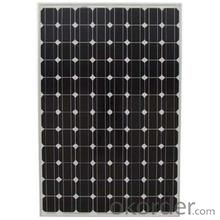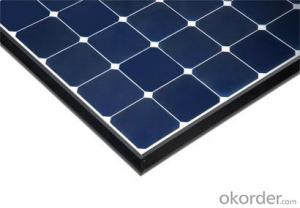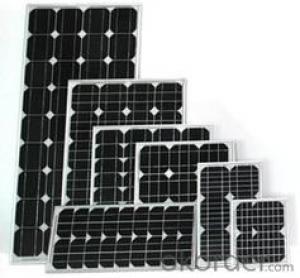CNBM On Grid System 700W with Certificate UL TUV CE
- Loading Port:
- Shanghai
- Payment Terms:
- TT OR LC
- Min Order Qty:
- 50 watt
- Supply Capability:
- 1000 watt/month
OKorder Service Pledge
OKorder Financial Service
You Might Also Like
Item specifice
CNBM On Grid System 700W with Certificate UL TUV CE
Product description
A grid-connected photovoltaic power system, or grid-connected PV system is anelectricity generating solar PV system that is connected to the utility grid. A grid-connected PV system consists of solar panels, one or several inverters, a power conditioning unit and grid connection equipment. They range from small residential and commercial rooftop systems to large utility-scale solar power stations. Unlike stand-alone power systems, a grid-connected system rarely includes an integrated battery solution, as they are still very expensive. When conditions are right, the grid-connected PV system supplies the excess power, beyond consumption by the connected load, to the utility grid.
Connection of the photovoltaic power system can be done only through an interconnection agreement between the consumer and the utility company. The agreement details the various safety standards to be followed during the connection.[4]
Solar energy gathered by photovoltaic solar panels, intended for delivery to a power grid, must be conditioned, or processed for use, by a grid-connected inverter. Fundamentally, an inverter changes the DC input voltage from the PV to AC voltage for the grid. This inverter sits between the solar array and the grid, draws energy from each, and may be a large stand-alone unit or may be a collection of small inverters, each physically attached to individual solar panels. See AC Module. The inverter must monitor grid voltage, waveform, and frequency. One reason for monitoring is if the grid is dead or strays too far out of its nominal specifications, the inverter must not pass along any solar energy. An inverter connected to a malfunctioning power line will automatically disconnect in accordance with safety rules, for example UL1741, which vary by jurisdiction. Another reason for the inverter monitoring the grid is because for normal operation the inverter must synchronize with the grid waveform, and produce a voltage slightly higher than the grid itself, in order for energy to smoothly flow outward from the solar array.

Application
Industrial
Commercial
Residential
Feature
Residential, grid-connected rooftop systems which have a capacity more than 10 kilowatts can meet the load of most consumers.[2] They can feed excess power to the grid where it is consumed by other users. The feedback is done through a meter to monitor power transferred. Photovoltaic wattage may be less than average consumption, in which case the consumer will continue to purchase grid energy, but a lesser amount than previously. If photovoltaic wattage substantially exceeds average consumption, the energy produced by the panels will be much in excess of the demand. In this case, the excess power can yield revenue by selling it to the grid. Depending on their agreement with their local grid energy company, the consumer only needs to pay the cost of electricity consumed less the value of electricity generated. This will be a negative number if more electricity is generated than consumed.[3] Additionally, in some cases, cash incentives are paid from the grid operator to the consumer.
Packaging
With carton and box
- Q:Can solar energy systems be used in residential areas with homeowners associations?
- Solar energy systems can indeed be used in residential areas with homeowners associations (HOAs), although the rules and regulations regarding these systems may differ depending on the specific HOA. Some HOAs may impose limitations on the size, type, and placement of solar panels, while others may have specific guidelines in place to ensure that the community maintains aesthetic and architectural harmony. In the United States, the federal government has passed legislation to safeguard homeowners' rights to install solar energy systems, even within HOAs. The Solar Rights Act, enacted in 1978, prohibits HOAs from outright forbidding the installation of solar energy systems. However, HOAs are allowed to impose reasonable restrictions to safeguard the overall aesthetics and property values of the community. If you reside in a residential area with an HOA and are interested in installing a solar energy system, it is crucial to carefully review the HOA's guidelines and restrictions. Many HOAs have established specific processes and procedures that homeowners must adhere to when seeking approval for solar panel installations. This may entail submitting a design proposal, obtaining the required permits, and complying with any architectural or aesthetic requirements. Furthermore, it is important to note that solar energy systems offer numerous advantages for homeowners and the community as a whole. They can reduce electricity expenses, boost property values, and contribute to a cleaner and more sustainable environment. As solar energy becomes increasingly popular and affordable, many HOAs are becoming more receptive to solar panel installations and are updating their guidelines accordingly. If you are contemplating installing a solar energy system in a residential area with an HOA, it is advisable to consult with the HOA board, carefully review the guidelines, and collaborate with a reputable solar installation company that is experienced in navigating HOA requirements. By following the proper procedures and working within the guidelines, it is possible to enjoy the benefits of solar energy while maintaining harmony within the residential community.
- Q:What is the maintenance cost of a solar energy system?
- The maintenance cost of a solar energy system can vary depending on several factors such as the size of the system, the type of components used, and the location of the installation. Generally, solar energy systems have minimal maintenance requirements and are considered to be low maintenance compared to other forms of energy generation. Regular maintenance tasks for a solar energy system may include cleaning the solar panels to ensure optimal performance, inspecting the wiring and connections for any damage or loose connections, and checking the inverter for proper functioning. These routine maintenance activities can typically be performed by the system owner or a professional technician. In terms of cost, the maintenance expenses for a solar energy system are typically quite low. The cleaning of solar panels can usually be done with basic equipment and materials, and the frequency of cleaning may vary depending on the level of dust or dirt accumulation in the area. Any necessary repairs or replacements of components may incur additional costs, but these instances are relatively rare, especially with high-quality solar systems. It is important to note that many solar energy system manufacturers offer warranties that cover the cost of repairs or replacements for a specified period. Additionally, some solar energy system owners choose to invest in service contracts or maintenance plans to ensure regular inspections and upkeep of their systems. Overall, while there are some maintenance requirements associated with a solar energy system, the costs are generally low in comparison to the long-term benefits and savings provided by the system's clean and renewable energy generation.
- Q:Can solar energy systems be used for powering satellites?
- Yes, solar energy systems can be used for powering satellites. Solar panels are often used to capture the sun's energy and convert it into electricity, which can then be used to power various systems on board satellites. This clean and renewable energy source is highly efficient in space, where sunlight is readily available and there are no obstructions to hinder solar panel performance.
- Q:Can solar energy systems be used in areas with high air pollution?
- Yes, solar energy systems can still be used in areas with high air pollution. While air pollution can potentially reduce the efficiency of solar panels by blocking sunlight and reducing the amount of energy they can generate, solar energy systems can still function and provide a renewable energy source even in polluted areas. Regular cleaning and maintenance of the solar panels can help mitigate the impact of air pollution on their performance. Additionally, installing solar energy systems can help reduce reliance on fossil fuels and contribute to the overall improvement of air quality in polluted areas.
- Q:How is solar energy stored for later use?
- Various methods exist for storing solar energy for later use. One widely employed approach involves the utilization of solar batteries or energy storage systems. These batteries become charged during daylight hours, when excess solar energy is being generated. Subsequently, the stored energy can be utilized during periods of limited or no sunlight, such as nighttime or cloudy days. An alternative means of storing solar energy is through the adoption of thermal energy storage systems. These systems convert solar energy into thermal energy, which is then stored in a medium like water or molten salt. This stored thermal energy can subsequently be utilized to produce electricity or heat whenever necessary. Moreover, solar energy can be indirectly stored through the utilization of pumped hydroelectric storage. Excess solar energy is employed to pump water from a lower reservoir to a higher one. When electricity is required, the stored water is released and flows down to a lower reservoir, generating electricity via turbines. In addition, solar energy can also be stored in the form of compressed air. Excess solar energy is utilized to compress air into storage containers. When electricity is needed, the compressed air is released and expanded through turbines, generating electricity. In conclusion, the storage of solar energy for future use plays a critical role in ensuring a consistent and uninterrupted power supply. These storage methods enable us to maximize the advantages of solar energy and overcome the challenges posed by its intermittent availability.
- Q:Can solar energy systems be used in areas with limited access to solar energy community initiatives?
- Yes, solar energy systems can still be used in areas with limited access to solar energy community initiatives. While the efficiency and effectiveness of solar energy systems may vary depending on the amount of sunlight available, advancements in technology have made it possible to harness solar energy even in areas with less sunlight. Additionally, individual households or businesses can install their own solar panels or systems to generate renewable energy for their own use, regardless of the availability of community initiatives.
- Q:How do solar energy systems impact energy reliability?
- Solar energy systems can significantly improve energy reliability by reducing dependence on traditional power grids. These systems generate electricity from sunlight, which is a renewable and abundant source of energy. By diversifying the energy mix, solar energy systems can help minimize the risks of power outages caused by fuel supply disruptions or natural disasters. Additionally, solar panels can be installed on rooftops, enabling decentralized power generation and reducing transmission losses. Overall, solar energy systems enhance energy reliability by providing a stable and sustainable source of electricity.
- Q:Can solar energy systems be used in areas with limited space?
- Yes, solar energy systems can be used in areas with limited space. There are various compact and space-efficient solar panels available, such as rooftop solar panels, solar awnings, and solar tiles, which can be installed in small areas. Additionally, advancements in technology have led to the development of flexible and portable solar panels that can be used in areas where traditional panels may not be suitable.
- Q:What is the role of batteries in off-grid solar energy systems?
- The role of batteries in off-grid solar energy systems is crucial as they serve as the primary storage devices for the generated solar energy. In off-grid systems, where there is no access to a utility grid, batteries are used to store excess solar energy produced during the day for use during the night or when the sun is not shining. Batteries store the energy in the form of chemical potential energy, which is converted back into electrical energy when needed. This allows for a continuous and reliable power supply, ensuring that electricity is available even when solar panels are not producing energy. Additionally, batteries provide stability and balance to the off-grid solar systems. They act as a buffer, absorbing fluctuations in energy production and demand. For instance, during periods of high energy demand, the batteries can discharge their stored energy to meet the load requirements, preventing any interruptions or power shortages. Furthermore, batteries also play a crucial role in maintaining the longevity and efficiency of the solar panels. By storing excess energy, batteries prevent the solar panels from being stressed by overproduction, which can lead to premature wear and tear or even damage. In conclusion, batteries are an essential component of off-grid solar energy systems as they enable energy storage, provide stability, and ensure a continuous power supply, making them indispensable for reliable and sustainable off-grid electricity generation.
- Q:What is the role of solar charge controllers in regulating the charging of batteries?
- The role of solar charge controllers is to regulate the charging of batteries by managing the flow of electricity from the solar panels to the batteries. They ensure that the batteries are charged efficiently and safely by monitoring the voltage and current levels, and adjusting the charging parameters accordingly. This prevents overcharging, which can damage the batteries, and also protects against over-discharging, which can shorten their lifespan. Solar charge controllers act as a crucial intermediary between the solar panels and batteries, optimizing the charging process to maximize the battery's performance and longevity.
1. Manufacturer Overview |
|
|---|---|
| Location | |
| Year Established | |
| Annual Output Value | |
| Main Markets | |
| Company Certifications | |
2. Manufacturer Certificates |
|
|---|---|
| a) Certification Name | |
| Range | |
| Reference | |
| Validity Period | |
3. Manufacturer Capability |
|
|---|---|
| a)Trade Capacity | |
| Nearest Port | |
| Export Percentage | |
| No.of Employees in Trade Department | |
| Language Spoken: | |
| b)Factory Information | |
| Factory Size: | |
| No. of Production Lines | |
| Contract Manufacturing | |
| Product Price Range | |
Send your message to us
CNBM On Grid System 700W with Certificate UL TUV CE
- Loading Port:
- Shanghai
- Payment Terms:
- TT OR LC
- Min Order Qty:
- 50 watt
- Supply Capability:
- 1000 watt/month
OKorder Service Pledge
OKorder Financial Service
Similar products
New products
Hot products
Related keywords




























